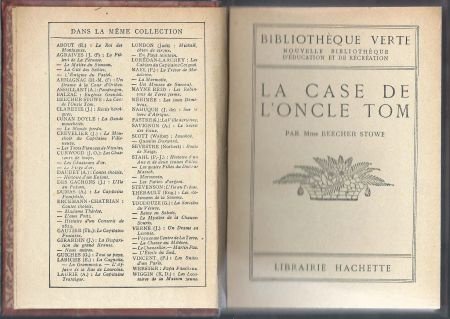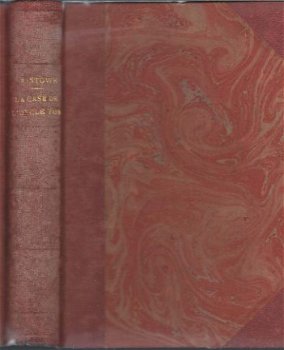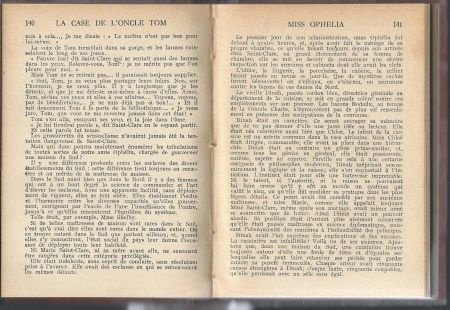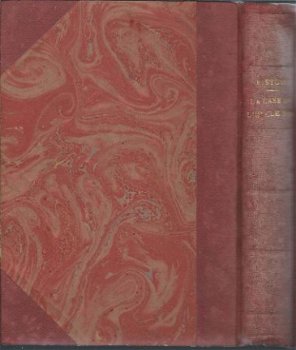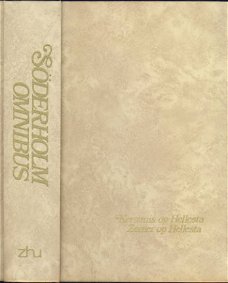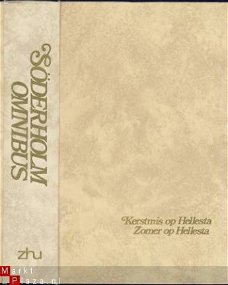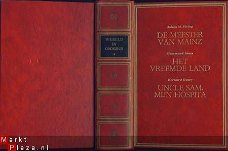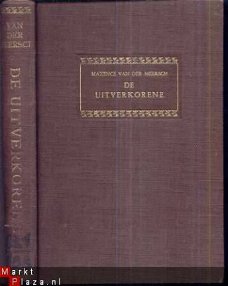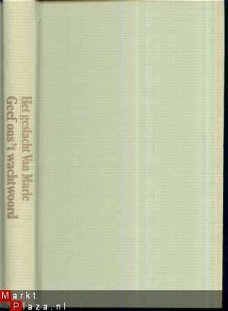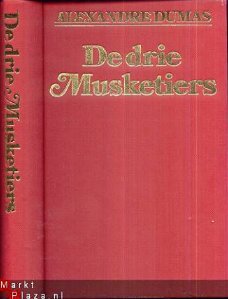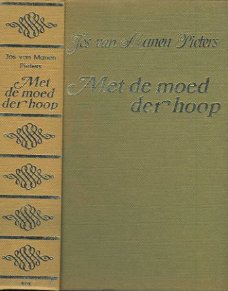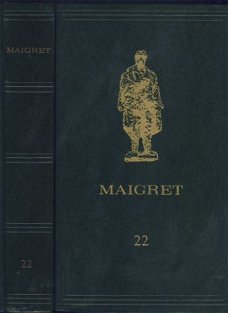
MME BEECHER STOWE**LA CASE DE L'ONCLE TOM**RELIURE HARDCOVER
Kenmerken
- Conditie
- Gebruikt
- Levering
- Niet van toepassing
Omschrijving
MME BEECHER STOWE
**LA CASE DE L'ONCLE TOM**
RELIURE HARDCOVER HACHETTE.
BIBLIOTHEQUE VERTE
NOUVELLE BIBLIOTHEQUE
D'EDUCATION ET DE RECREATION.
LIBRAIRIE HACHETTE
ARTICLE INVENTAIRE CODE 72.327
FORMAT 167 X 122 X 23 + 282 PGS + 277 GRMS
EXPEDITION EN BELGIQUE 2,35 EURO
Harriet Elisabeth Beecher was born in Litchfield, Connecticut on June 14, 1811.[1] She was the seventh of 13 children,[2] born to outspoken religious leader Lyman Beecher and Roxana (Foote), a deeply religious woman who died when Stowe was only five years old. Her notable siblings included a sister, Catharine Beecher, who was an educator and author, as well as seven brothers[citation needed] who became ministers: including Henry Ward Beecher, Charles Beecher, and Edward Beecher.
Harriet enrolled in the seminary (girls' school) run by her sister Catharine, where she received a traditionally "male" education in the classics, including study of languages and mathematics. Among her classmates there was Sarah P. Willis, who later wrote under the pseudonym Fanny Fern.[3] At the age of 21, she moved to Cincinnati, Ohio to join her father, who had become the president of Lane Theological Seminary. There, she also joined the Semi-Colon Club, a literary salon and social club whose members included the Beecher sisters, Caroline Lee Hentz, Salmon P. Chase, Emily Blackwell, and others.[4]
It was in that group that she met Calvin Ellis Stowe, a widower and professor at the seminary. The two married on January 6, 1836.[5] He was an ardent critic of slavery, and the Stowes supported the Underground Railroad, temporarily housing several fugitive slaves in their home. They had seven children together, including twin daughters.
Early portrait of Harriet Beecher Stowe, 1853
In 1850, Congress passed the Fugitive Slave Law, prohibiting assistance to fugitives. At the time, Harriet had moved with her family into a home on the campus of Bowdoin College, where her husband was now teaching. On March 9, 1850, Stowe wrote to Gamaliel Bailey, editor of the weekly antislavery journal National Era, that she planned to write a story about the problem of slavery: "I feel now that the time is come when even a woman or a child who can speak a word for freedom and humanity is bound to speak... I hope every woman who can write will not be silent."[6] Shortly after, In June 1851, when she was 40, the first installment of her Uncle Tom's Cabin was published in the National Era. She originally used the subtitle "The Man That Was A Thing", but it was soon changed to "Life Among the Lowly".[1] Installments were published weekly from June 5, 1851, to April 1, 1852.[6] Uncle Tom's Cabin was published in book form on March 20, 1852, by John P. Jewett with an initial print run of 5,000 copies.[7] Each of its two volumes included three illustrations and a title-page designed by Hammatt Billings.[8] In less than a year, the book sold an unprecedented three hundred thousand copies.[9] By December, as sales began to wane, Jewett issued an inexpensive edition at 37 1/2 cents each to further inspire sales.[10]
The book's emotional portrayal of the impact of slavery captured the nation's attention. It added to the debate about abolition and slavery, and aroused opposition in the South. Within a year, 300 babies were named "Eva" in Boston alone and a play based on the book opened in New York in November of that year.[11]
After the start of the Civil War, Stowe traveled to Washington, D.C. and there met President Abraham Lincoln on November 25, 1862.[12] Legend has it that, upon meeting her, he greeted her by saying, "so you are the little woman who wrote the book that started this great war."[13] In reality, little is known about the meeting. Stowe's daughter Hattie reported, "It was a very droll time that we had at the White house [sic] I assure you... I will only say now that it was all very funny—and we were ready to explode with laughter all the while."[14] Stowe's own letter to her husband is equally ambiguous: "I had a real funny interview with the President."[14]
[edit]Later years
In the 1870s, Stowe's brother Henry Ward Beecher was accused of adultery, and became the subject of a national scandal. Stowe, unable to bear the public attacks on her brother, fled to Florida but asked family members to send her newspaper reports.[15] Through the affair, however, she remained loyal to her brother and believed he was innocent.[16]
Mrs. Stowe was among the founders of the Hartford Art School which later became part of the University of Hartford.
Stowe died on July 1, 1896, at age eighty-five in Hartford, Connecticut. She is buried in the historic cemetery at Phillips Academy in Andover, Massachusetts.
[edit]LegacyHarriet Beecher Stowe House in Cincinnati, Ohio
Bust by Brenda Putnam at Hall of Fame for Great Americans
Landmarks
Multiple landmarks are dedicated to the memory of Harriet Beecher Stowe, and are located in several states including Ohio, Florida, Maine and Connecticut. The locations of these landmarks represent various periods of her life such as her father's house where she grew up, and where she wrote her most famous work.
The Harriet Beecher Stowe House in Cincinnati, Ohio is the former home of her father Lyman Beecher on the former campus of the Lane Seminary. Her father was a preacher who was greatly affected by the pro-slavery Cincinnati Riots of 1836. Harriet Beecher Stowe lived here until her marriage. It is open to the public and operated as a historical and cultural site, focusing on Harriet Beecher Stowe, the Lane Seminary and the Underground Railroad. The site also presents African-American history.[17]
In the 1870s and 1880s, Stowe and her family wintered in Mandarin, Florida, now a neighborhood of modern consolidated Jacksonville, on the St. Johns River. Stowe wrote Palmetto Leaves while living in Mandarin, arguably an eloquent piece of promotional literature directed at Florida's potential Northern investors at the time.[18] The book was published in 1873 and describes Northeast Florida and its residents. In 1870, Stowe created an integrated school in Mandarin for children and adults. This predated the national movement toward integration by more than a half century. The marker commemorating the Stowe family is located across the street from the former site of their cottage. It is on the property of the Community Club, at the site of a church where Stowe's husband once served as a minister. The Church of our Saviour is an Episcopal Church founded in 1880 by a group of people who had gathered for Bible readings with Professor Calvin E. Stowe and his famous wife. A church was constructed in 1883 which contained the Stowe Memorial stained glass window, created by Louis Comfort Tiffany.[19]
The Harriet Beecher Stowe House in Brunswick, Maine is where Stowe lived when she wrote Uncle Tom's Cabin. Her husband was teaching theology at nearby Bowdoin College, and she regularly invited students from the college and friends to read and discuss the chapters before publication. Future Civil War general, and later Governor, Joshua Chamberlain was then a student at the college and later described the setting. “On these occasions,” Chamberlain noted, “a chosen circle of friends, mostly young, were favored with the freedom of her house, the rallying point being, however, the reading before publication, of the successive chapters of her Uncle Tom’s Cabin, and the frank discussion of them.” In 2001 Bowdoin College purchased the house, together with a newer attached building, and was able to raise the substantial funds necessary to restore the house. It is not open to the public.
The Harriet Beecher Stowe House in Hartford, Connecticut is the house where Stowe lived for the last 23 years of her life. It was next door to the house of fellow author Mark Twain. In this 5,000 sq ft (460 m2) cottage-style house, there are many of Beecher Stowe's original items and items from the time period. In the research library, which is open to the public, there are numerous letters and documents from the Beecher family. The house is open to the public and offers house tours on the half hour.
In 1833, during Stowe's time in Cincinnati, the city was afflicted with a serious cholera epidemic. To avoid illness, Stowe made a visit to Washington, Kentucky, a major community of the era just south of Maysville. She stayed with the Marshall Key family, one of whose daughters was a student at Lane Seminary. It is recorded that Mr. Key took her to see a slave auction, as they were frequently held in Maysville. Scholars believe she was strongly moved by the experience. The Marshall Key home still stands in Washington. Key was a prominent Kentuckian; his visitors also included Henry Clay and Daniel Webster.[20]
The Uncle Tom's Cabin Historic Site is part of the restored Dawn Settlement at Dresden, Ontario, which is 20 miles east of Algonac, Michigan. The community for freed slaves founded by the Rev. Josiah Henson and other abolitionists in the 1830s has been restored. There's also a museum. Henson and the Dawn Settlement provided Stowe with the inspiration for Uncle Tom's Cabin.[21]
[edit]Honors
Stowe is honored with a feast day on the liturgical calendar of the Episcopal Church (USA) on July 1.
On June 13, 2007, the United States Postal Service issued a 75¢ Distinguished Americans series postage stamp in her honor.
In early 2010, Stowe was proposed by the Ohio Historical Society as a finalist in a statewide vote for inclusion in Statuary Hall at the United States Capitol.
[edit]Partial list of works
The Mayflower; or, Sketches of Scenes and Characters Among the Descendants of the Pilgrims (1834)
Mark Meriden (1841)
Uncle Tom's Cabin (1852)
A Key to Uncle Tom's Cabin (1853)
Dred, A Tale of the Great Dismal Swamp (1856)
The Minister's Wooing (1859)
Agnes of Sorrento (1862) (reading online)
The Pearl of Orr's Island (1862)
The Chimney Corner (1866) (chapters published in Atlantic Monthly Volume 18)
The American Woman's Home (1869) (with Catherine Beecher) (see summary and links to the book here)
Old Town Folks (1869)
Little Pussy Willow (1870)
Lady Byron Vindicated (1870)
My Wife and I (1871)
Pink and White Tyranny (1871)
Woman in Sacred History (1873)
Palmetto Leaves (1873)
We and Our Neighbors (1875)
Poganuc People (1878)
The Poor Life (1890)
As Christopher Crowfield
House and Home Papers (1865)
Little Foxes (1866)
See alsoSaints portal
Harriet Beecher Stowe House (Cincinnati, Ohio)
Origins of the American Civil War
